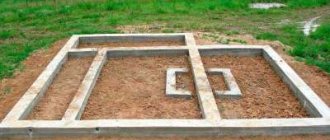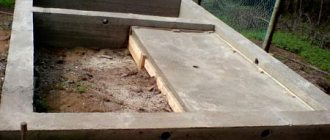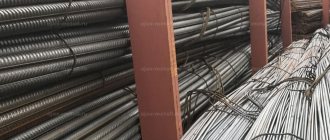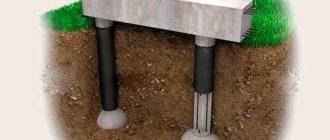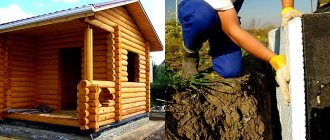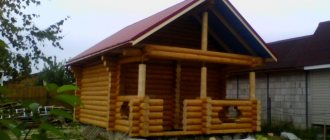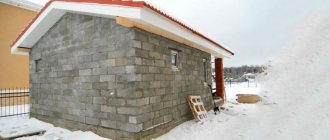Despite the significant material and labor costs of building a slab foundation for a bathhouse, in some cases this is the only type of foundation that can be effective in the given conditions.
At the same time, it is possible to build a power structure without involving highly qualified performers in the work.
We’ll tell you in this article how to build a slab foundation for a bathhouse yourself.
In what cases is a slab base used?
Construction technology involves a large amount of work related to:
- soil extraction,
- installation of a reinforcing frame,
- compaction of concrete screed, etc.
At the same time, a bathhouse on a slab foundation will last for decades even in such problem areas as peat bogs, wetlands and other unstable soils.
The high load-bearing capacity of a monolithic foundation allows you to build baths from:
- timber,
- bricks,
- concrete,
and also to complete the second floor.
Advantages and disadvantages
Regarding the choice of slab base for a bathhouse, the technology will have the following advantages:
- The “floating” foundation rises and falls along with the soil, which is subject to frost heaving forces, so the structure during operation does not experience additional loads associated with the geological features of the site.
- Due to the large supporting area, the slab base has significant load-bearing capacity, which makes it effective for the construction of bathhouses with massive walls and heavy stoves.
- Long service life - from 70 years.
- Possibility of building with your own hands.
Restrictions on choosing a slab foundation for a bathhouse:
- high consumption of building materials;
- labor intensity of work;
- the need to rent special equipment;
- ineffective construction in areas with difficult terrain.
Based on the above, if an individual developer decided to build a bathhouse on a problem area, then laying a slab foundation would be a rational choice in this situation.
The choice depends on the type of bath
Depending on the type of construction, you can choose the appropriate type of foundation.
- So, for a light-weight frame bath, a columnar foundation is suitable.
- A log or timber frame will create a large load on the foundation, so it is preferable to choose a strip foundation.
- A bathhouse made of aerated blocks is lighter than a brick one, but heavier than a frame one. Therefore, it is more correct to focus on the strip type of foundation.
Foundation for a frame bath
Foundation for a frame bath - concrete columns
As you know, a columnar foundation is the cheapest option of all types, and a frame bathhouse is the lightest of the bathhouses. That is why in most cases it is justified to use columnar.
The advantages of a columnar foundation for a frame bath are listed below:
- price - a similar type of building foundation costs at least one and a half times cheaper than others (drilled-rammed, pile-screw, slab or strip);
- ease of installation - you do not need to have special education to lay a brick or cinder block on cement or bury a pipe in the ground. As you can see, installing this type of base does not require special skills, tools or special equipment;
- speed of construction - compared to other types of building foundations, a columnar foundation takes much less time to create, which means it is built faster;
- soil instability - a pillar base is optimal for installation in unstable soil (sandy or clayey), as well as in soil that is subject to deep freezing.
Another advantage of the columnar type of foundation is that it does not require thermal insulation (in this type of foundation, special attention is paid to good and high-quality floor insulation). For all the nuances of this type, as well as when you shouldn’t use it, see the article “What is good about a columnar foundation?”
For all the nuances of this type, as well as when you shouldn’t use it, see the article “What is good about a columnar foundation.”
A more detailed article about foundations for frame baths is here.
Building size and thickness of monolithic structure
A monolithic foundation is the most expensive type of foundation, which explains the desire of developers to determine the minimum permissible slab thickness that would withstand design loads with a margin.
Factors influencing the indicator:
- reinforcement frame height;
- thickness of the concrete layer above and below the mesh;
- reinforcement thickness.
For baths made of light material - frame-panel or wooden, it is enough to add these three values to find out the thickness of the monolith. The optimal slab size is considered to be 0.2–0.3 m.
In this case, it is necessary to take into account the height of the cushion made of non-metallic materials , which in most cases will be equal to 0.5 m: 0.3 m of sand and 0.2 m of crushed stone. In regions with sharp temperature changes, experts advise placing a layer of insulation 0.1 m high under the slab.
If large-scale construction is underway, for example, a bathhouse with an area of 6 x 6 m, then the weight of the building must also be taken into account, since there is a possible risk of slab foundation subsidence, especially on unstable soils. In this case, the thickness of the slab is increased to 35–40 cm.
For economic feasibility purposes, the monolith can be replaced with a foundation using ready-made factory-type reinforced concrete slabs or a foundation with stiffeners can be built.
What it is?
The “Swedish slab” is a shallow slab base. The main distinctive feature of the design is the insulation of the monolithic slab with a layer of expanded polystyrene laid underneath it.
This allows the foundation not to transfer heat from the house, but, on the contrary, to accumulate it and return it to the living space on the first floor.
| Price comparison in rubles for the construction of a foundation using various technologies per cubic meter | ||
| Monolithic slab on a pillow | Insulated Swedish stove with built-in system for heated floors | Finnish slab foundation |
| 6000–8000 | 8000–10000 | 9500–11500 |
Sectional view of the device with photo and installation technology
The slab foundation using Swedish technology consists of the following layers (from bottom to top):
- Leveled and compacted soil.
- Geotextiles with laid drainage pipes.
- Compacted sand base.
- Thermal insulation material.
- Waterproofing.
- Thermal insulation material.
- Reinforcement frame.
- Heated floor pipes.
- Concrete slab.
- Finish floor covering.
To prevent the forces of frost heaving, a drainage system is installed along the contour of the structure to drain groundwater. If sand and crushed stone are used to construct the cushion, then geotextiles are laid between them. All communication and engineering networks are laid in the base body under a monolithic slab.
The photo shows an insulated Swedish stove:
Sequence of technological stages of construction:
- Preparing the site, removing the fertile layer up to 40 cm high.
- A device at the bottom of the recess of a layer of geotextile.
- Laying and compacting the pillow.
- Construction of formwork.
- Installation of a drainage system around the perimeter of the structure.
- Laying utility networks.
- Device of thermal insulation material.
- Installation of reinforced frames on substrates.
- Installation of pipes for a floor heating system with subsequent connection to the collector and air supply.
- Pouring the entire structure with concrete.
Area of use
Slab foundations using Swedish technology are widely used in the CIS countries and most often for the construction of such structures:
- houses made of logs and timber;
- frame-panel buildings;
- buildings made of foam concrete and other lightweight materials.
Ground conditions:
- sand;
- clay;
- sandy loam;
- loam;
- water-saturated soil.
Pros and cons of technology
Advantages:
- Reducing construction time due to the simultaneous installation of utilities and laying the foundation.
- Thermal insulation material reduces heat loss through the base, thereby reducing home heating costs.
- After hardening, the smooth surface of the monolithic slab is ready for laying the finishing floor covering.
- The soil under the base does not freeze, which reduces vertical pressure forces from the soil resulting from frost heaving.
- Construction work is done without the use of heavy equipment.
Disadvantages of USP grounds:
- Not suitable for construction on soils with a high degree of heaving.
- Significant material costs for laying a power structure.
- Not designed for the construction of heavy structures, including multi-storey buildings.
- Not suitable for the construction of houses in which the design includes a basement.
How to do it yourself?
To build a power structure, you can always invite highly specialized specialists to work . If the owner plans to do the foundation work with his own hands, he first needs to understand the construction technology and develop a project in accordance with current standards.
Terrain marking
After designing and preparing building materials, equipment and tools, the developer can begin the first stage of construction - marking the site. To do this, you need to prepare the site: remove construction debris and objects that interfere with work.
Markings are applied strictly according to plan. As a rule, the area of the pit is 1–2 meters larger than the dimensions of the bathhouse itself.
They mark the contour of the working field using reinforcing bars driven into the ground at the corners of the structure, as well as cords stretched between them. At the end, proportionality is checked by comparing the diagonals.
Excavation
Under the slab foundation, the builder needs to develop a pit to the designed depth.
Shovel work will take a lot of time and effort, and you will also have to cut off the roots of trees and shrubs. The depth of the pit can vary from 0.5 to 1 m depending on the type of soil on the site and design construction conditions.
The bottom of the excavated recess must be level in one horizontal plane and thoroughly compacted.
Manufacturing of formwork
The role of formwork is to provide a clear shape and design dimensions in the space of the finished monolithic structure. At the developer’s choice, the formwork can be removable (wooden, metal, plastic) or permanent (made of polystyrene foam) and at the same time serve as insulation.
In most cases, in private construction they choose the most budget-friendly method - installation of wooden panel formwork , knocked down with your own hands from boards or plywood.
The formwork is built along the perimeter of the pit, fixing the position of the panels from the outside with supports in increments of 0.5–1 m. The contour of the formwork can also be knocked down from the outside with wooden planks so that the structure does not move apart under the pressure of the solution.
For permanent formwork, insulation is installed on the inside in the form of slabs of polystyrene foam or other material with a low degree of thermal conductivity.
Filling the bottom of the pit
To reduce the effect of soil movements on the base of the bathhouse, a cushion of non-metallic materials - crushed stone and sand - is placed at the bottom of the pit. Before this, the surface of the earth is covered with geosynthetic material, which at the same time does not allow the soil and fill to mix with each other, and also acts as a barrier against the seepage of groundwater into the structure of the foundation base.
The geotextile layer is covered with an even layer of sand. The work uses purified bulk material - quarry or river sand.
The thickness of the compacted sand cushion must be at least 0.3 m . Tamping can be done manually, but the work will be more efficient if you rent a vibrating plate.
The sand is covered with medium-fraction crushed stone with a layer thickness of 0.2–0.3 m. The bulk material is also carefully compacted to obtain the most compacted and stable bottom.
Pouring a concrete pad
Pouring a concrete pad allows the developer to get a level base for the future bathhouse.
This is a low concrete screed, which should be distinguished from a foundation slab. Since at this stage of construction there is no need for a large consumption of material, they do not skimp on the quality of concrete, giving preference to high-quality solutions .
To completely harden, the concrete layer requires no more than 10 days.
A concrete pad is placed on top of the layers of hydro- and thermal insulation of the foundation. Polyethylene film or roofing felt is used as a waterproofing material, and extruded polystyrene foam is used as a heat insulator.
Reinforcement
Reinforcing frame - a spatial structure made of reinforcing steel bars . As a rule, these are two meshes that are placed in a horizontal plane and connected to each other by vertical rods.
The purpose of the reinforcement is to ensure the resistance of the slab foundation to tensile loads, as well as additional strength and rigidity to the base for the bathhouse.
The process of manufacturing a reinforced frame for a foundation is controlled by current standards (SNiP 52–01–2003 in the latest edition). The developer can order a ready-made power structure or assemble a frame from reinforcement with his own hands.
Steel rods must be recessed into the body of the monolithic slab by at least 5 cm on all sides. To maintain the design distance, builders use fixings, for example, pieces of crushed brick.
Installation of water drainage and power supply systems
For ease of operation of the bathhouse, drainage elements can be placed directly in the foundation slab. To ensure that sewer drain parts remain in working condition for a long time, they are placed in special sleeves. The absence of overhead water lines allows the developer not to carry out thermal protection of the water supply system from freezing.
It is also possible to install an electrical supply system into the slab foundation . The technology makes it possible to install a spiral pipeline in the foundation slab through which hot water will move in order to obtain a “warm floor” type structure.
Pouring the slab
Concrete is poured into the finished formwork with a reinforced frame installed inside.
The complexity of the technological stage lies in the fact that the screed requires a large volume of mortar, and the concreting process itself must be carried out in one stage .
Otherwise, the surface of the lower concrete layer will have time to set and the result will be a monolith with a heterogeneous structure, the strength of which will be significantly lower than the design value.
For a small slab, you can rent a concrete mixer or prepare the solution yourself using a shovel. If the area of the bathhouse is more than 6 by 6 meters, then it is more advisable to order factory-made concrete, which in the required volume will be delivered to the site immediately before the start of pouring, as required by the technology.
After pouring, air bubbles remain in the body of liquid concrete, which must be removed in order to obtain a dense and uniform structure of a durable monolith. This can be done by bayoneting the surface of the solution with reinforcement, but it will be faster, easier and more effective if you use a special vibration installation for this purpose.
Concrete maintenance and formwork removal
According to the technology for constructing reinforced concrete structures, concrete must harden at a certain temperature in order to become a strong and durable monolith. If the slab dries too quickly or changes in ambient temperature, cracks may appear in the slab.
To prevent this from happening, the concrete surface is covered with woven fabric (hay, film) and periodically irrigated with water . If construction is carried out in winter, then special heating ingredients are added to the solution.
When a gap appears between the formwork panels and the slab, you can begin dismantling the molding structure.
Monolithic slab: technology for building a foundation for a bathhouse
The construction of a monolithic base for a bathhouse is justified if there are heaving soils on the building site, as well as deeply frozen, water-filled soils.
The construction of a foundation for a bathhouse (monolithic slab) should begin by clearing the site of debris, existing buildings, and uprooting trees and shrubs. Foundation area
The surface of the site is leveled, after which the perimeter of the future building is marked with pegs. A construction cord is pulled between the pegs, which serves to determine a more accurate direction when marking the foundation slab.
A monolithic foundation (slab) can be poured on the ground surface, provided that the construction site has gravelly or rocky soils; in all other cases, it is necessary to deepen the base slab into the ground, for which it is necessary to dig a pit of a certain depth. The depth of the pit should be 40 cm greater than the height of the foundation slab planned for construction. The width of the pit is 10 cm wider on each side than the dimensions of the bathhouse in plan.
Construction of a cushion made of sand and crushed stone
The bottom of the pit is carefully compacted, covered with a layer of geotextile, after which a layer of coarse sand is poured. Carefully leveling the poured layer, compact it, pouring water on the sand preparation. Soil compaction is most easily accomplished with vibrating rammers.
Then construction crushed stone is poured over the layer of compacted sand, which also needs to be leveled and compacted with special care.
Formwork and frame installations
After completing the installation of the sand and crushed stone cushion, you can begin to manufacture and install formwork panels. Formwork can be reused, especially if it is reusable panels. Before installing such formwork structures, they should be thoroughly cleaned of debris, dirt, and streaks of concrete mortar.
Construction of monolithic slab formwork
When making formwork panels from boards, it is important to ensure a tight fit of the individual elements, eliminating the appearance of gaps. Finished formwork elements are installed strictly vertically in the pit, reinforced with slopes and supports
The finished formwork elements are installed strictly vertically in the pit, reinforced with slopes and supports.
The reinforcement frame for the foundation of the bathhouse is welded from reinforcing bars, the step between individual rods is no more than 20 cm. To connect the reinforcement into a spatial frame, you can use a welding machine or knitting wire. The technical characteristics of a knitted frame are much higher than its welded counterpart, so the priority is to reinforce the foundation of the bathhouse with a knitted frame.
Concreting the slab base
Pouring concrete mortar into the formwork should be done quickly and accurately, trying to complete the technological process in one day. The concrete mixture is poured starting from the corner of the foundation support (from two corners at once). The surface of the poured concrete is leveled and compacted using vibrators - the monolithic slab must have a perfectly flat and smooth surface.
Securing the foundation slab
A monolithic slab for a bathhouse will gain strength for at least 28 days, so there will be a forced technological break in construction work.
At this time, it is necessary to provide care for the concrete surface, especially if the work is carried out in the hot summer. It is necessary to frequently moisten the surface of the slab and cover the structure with plastic film.
Uneven drying of concrete causes deformation of the slab foundation, so caring for the surface of a slab foundation is an important operation that should not be forgotten. A monolithic foundation gains 70% strength in two weeks, by which time the formwork can be dismantled
Features of building a foundation for a furnace
Regardless of the type of foundation for the bathhouse, the load-bearing structure under the stove must be built autonomously. This is due to the fact that the heating device has significant weight and can shrink during service.
The foundations for the stove and the bathhouse itself must be separated by a sand cushion with a width of at least 0.5 m . In this case, each side of the base should be 5–10 cm larger than the dimensions of the heating device.
The foundation under the furnace is laid below the freezing depth. This can be a monolithic structure with a high sand cushion and a reinforcing frame or piles. In the first case, a pit is dug to the design depth, a compacted cushion is installed, formwork is installed, a reinforcement frame is laid, and the space is concreted.
Boundary formwork
Monolithic slab in formwork
A monolithic foundation slab must have clear geometric boundaries and smooth vertical side surfaces. In addition, when pouring, a plastic concrete mixture in a semi-liquid state is used, which can leak outside the foundation structure. Therefore, it is necessary to install restrictive formwork from separate panels, which is mounted along the edges of the pit 300 - 500 mm above ground level.
Formwork panels can be metal, planks or assembled from moisture-resistant plywood, OSB boards, flat slate sheets. During installation, the formwork is securely fixed from the outside with spacers resting on the ground. The upper above-ground part of the foundation forms the base of the bathhouse, which can be insulated with dense extruded polystyrene foam at the stage of installing the formwork.
Possible mistakes and tips for construction
Despite the fact that a bathhouse is a lightweight building, heaving and moisture-saturated soils are not a reliable basis for such a structure .
Most problems associated with the geology of the site can be solved by increasing the cushion.
When calculating the parameters for the foundation for a bathhouse, you need to take concrete of a grade not lower than M250 , for unstable soils and heavy structures - from M300 and higher.
It is possible to obtain a solution with the desired qualities regarding moisture and frost resistance through additional additives to the solution.
Experts recommend not limiting yourself to one layer of waterproofing on a bed of sand and crushed stone. The building will last much longer if the outer surface is protected from moisture with a layer of liquid rubber or bitumen-based mastic.
Building a stove on the same foundation that is used for the bath itself is a violation of fire safety requirements. Depending on the design weight of the heating device, the base under it can be deep-seated or columnar.
A lot of important and useful information about the construction of a slab foundation is presented in this section.
Preparing the site
Once the foundation design has been chosen, it is necessary to carefully consider methods for strengthening it (if the soil is unstable or the groundwater is located very high). In addition, experts do not recommend erecting buildings on peat, fine sand or silt soil. If the choice of location is limited, then you have to build a cushion of sand and gravel 20 cm thick.
The next step is to determine the depth and width of the structure. The foundation should be 10 cm wider than the walls. The optimal depth of the foundation for a bathhouse is below the freezing level. Before starting construction, it is necessary to mark using pegs, a cord, a right triangle and a level.
The process should start from one of the corners of the future bathhouse. You need to drive a peg and put a triangle on it. On its two sides the length of two walls is measured, which will be located perpendicular to each other. In those places where they end, two more pegs are driven in. The triangle is then transferred to one of the new pegs to determine the location of the next wall intersection. It should be a rectangle. To make sure that the corners are even, you need to check the length of the diagonals - they must be the same.
Next, at a distance of 1-2 m from the pegs, it is necessary to arrange a cast-off of boards and posts. The boards are located at a distance of approximately 1 m from the ground. Cast-off boards must be packed parallel to the future walls. Then the axial parameters of the future structure are applied to the cast-off using small notches, into which nails should then be driven. The nails are connected with a cord (these are center lines), and the level is checked.
The next step is to take a plumb line and copy the center lines on the ground and put all the necessary dimensions on them. In accordance with the dimensions, you need to draw lines on the ground that indicate the internal and external contours of the foundation.
Proper care of concrete
A do-it-yourself foundation slab for a bathhouse needs maintenance. After pouring, it is covered with plastic film or woven cloth. In dry and hot weather, concrete is moistened with water to prevent cracks from appearing and not to weaken the load-bearing capacity of the base. In cold times of the day, when the temperature drops sharply below +5 degrees, technological heating is carried out. The formwork is dismantled after five days, and the sauna slab itself gains 100% strength after a month.
Finishing the foundation with stone
After the monolithic slab for the bathhouse has dried and the structure itself has been partially erected, it is necessary to think about finishing the above-ground part of the foundation. The plinth cladding gives the building a beautiful appearance and protects it from mechanical damage and getting wet. It evenly distributes the load from the structure to the base. The finishing material should not only be attractive, but also durable. A popular option is natural and artificial stone. It offers a wide selection of shades and textures and is considered durable and practical. A bathhouse on a slab foundation, decorated with stone underneath, looks rich.
A quick way to finish the base is using flexible stone. It consists of two layers: sand agglomerate and acrylic dispersion. It is cut with a stationery knife and mounted with glue.
To install stone tiles, the surface is leveled and primed for better adhesion. Glue is used based on cement or polymer. At the end, the seams are treated with grout.
Reinforcement cage
The reinforcement in the body of a concrete monolithic slab serves to increase the strength of the structure and protects the concrete mass from cracking and the appearance of shrinkage cracks.
Often, a special mesh is placed on the top of the reinforcement belt for attaching a “warm floor” heating system, which will make the floor in the bathhouse warm and comfortable. The reinforcement frame is a spatial volumetric configuration of individual metal rods connected to each other by knitting wire.
The metal frame consists of working rods with a diameter of 12 to 16 mm of a periodic corrugated profile, and distribution (mounting) fittings made of smooth wire with a diameter of 5 – 6 mm. The working rods are used to make a reinforcing mesh with a cell size of 150 x 150 mm or 200 x 200 mm.
In the spatial shape of the frame, reinforcing mesh is placed in the upper and lower parts of the monolithic slab. To combine two reinforcing meshes into a single structure, mounting reinforcement is used. All parts of the frame are connected to each other with soft knitting steel wire.
When installing the reinforcement cage, you must remember to create a protective layer of 25-30 mm to the outer edge of the foundation slab.
Concreting the foundation slab
Two important differences: shallow or deep
Before considering the types of foundations in detail, two main types should be distinguished - shallow and deep.
The difference is in the depth of immersion in the ground. Why is this moment important? In winter, the top layer of soil freezes, and all the moisture in it turns into ice. When it freezes, it expands, causing the top layer of soil to change its volume. This phenomenon is called “frost heaving”, it is typical for soils with a high moisture content, clay and loam.
The depth of soil freezing depends on average annual temperatures and soil composition. For deep ones, the basic rule is to immerse below the freezing point to eliminate the effects of heaving loads. For some areas, this type is difficult to implement - the soil can freeze to 2.4 meters. There is a way out.
A shallow type is used, the feature of which is a shallow immersion depth. Such a base is located in the upper layers of the soil, above the freezing point, but the loads from heaving processes are much lower - 2 or even 3 times.
The point is to properly arrange the foundation: the trench is dug a little wider, a sand cushion is installed, a concrete strip is erected, which is subsequently filled with sand on the sides. As a result, there is a sand cut-off on all sides.
Sand does not retain moisture; it goes deeper in warm weather, so there is nothing to freeze in winter.
Only loads emanating from the lower layers of the soil remain, so it is impossible to use a shallow type of foundation on soils with large seasonal heaves.
Why is reinforcement needed?
If a house is built on soil with poor load-bearing characteristics or in a place where groundwater is located quite high, a foundation made of monolithic slabs is mandatory.
Concrete slabs are very durable and can handle heavy loads very well. However, the weight of the building is not distributed evenly across the foundation. In this regard, kinks and curvatures of the concrete may occur, which can subsequently lead to the destruction of the base of the building.
Reinforcement of the slab foundation prevents this process. The reinforcement reliably binds and strengthens the concrete slab as much as possible, preventing it from deforming.
Types of LF
Bathhouse foundations differ in the method of construction (prefabricated and monolithic) and the depth of their location (shallow and deep). All these types of bases are designed for certain conditions.
Made
The indisputable advantage of a prefabricated foundation is:
- quick installation from reinforced concrete blocks;
- the almost complete absence of wet processes allows construction to be carried out in winter at subzero air temperatures;
- The blocks are convenient to use for creating a basement.
Jellied
Advantages:
- the construction of a monolithic strip attracts developers with its cost-effectiveness;
- The only equipment used is a mortar mixer and a vibrator;
- the work is carried out using hand tools;
- the technology of knitting reinforcement with wire eliminates the use of a welding machine;
- The high load-bearing capacity of the strip foundation allows you to build a bathhouse using heavy structures.
The disadvantages of poured foundations include:
- large time costs for the manufacture and installation of formwork, reinforcement and hardening of concrete (about 1 month);
- impossibility of laying a foundation in the cold season. Heating concrete in winter significantly increases the estimated cost of building a bathhouse.
Shallow
Most bath structures are built from lightweight materials such as wood, gas and foam concrete. With a small depth of soil freezing (300 - 400 mm), it is advisable to erect shallow foundation strips from 800 mm to 1200 mm.
The small height of the base profile allows you to make do with a minimum amount of materials (cement, sand, crushed stone and reinforcement). Read more about this type of foundation in this article.
Deeply buried
This type of foundation is chosen when there is a large freezing depth and when planning the construction of basements. It is extremely unprofitable to erect monolithic walls in large volumes, both financially and due to the seasonality of the work. Therefore, reinforced concrete foundation blocks and slabs are used for deep strip foundations.
Foundation drawings and sectional plans
Graphic documents drawn up when designing a slab foundation are plans and drawings that provide detailed information about the planned object, namely:
- dimensions;
- form;
- axes;
- layer sizes;
- reinforcement scheme;
- options for heat and waterproofing;
- plans for laying utility lines.
Below are approximate plans for a slab base:
View from above:
In section:
For example, the diagram below shows a diagram of a reinforced frame, where:
- Reinforcing bars of class A3, diameter 12-16 mm, pitch – 200 mm.
- Reinforcing bars A3 with a diameter of 8 mm, cell size 400x400 mm.
- Protective layer of concrete 35 mm thick.
In addition to the general diagram, the communications plan must necessarily reflect all the diameters of the utility lines in order to give an idea of the size of the inlet openings for builders:
Excavation
A slab foundation, like any other, begins with markings for excavation work.
The size of the pit in the plan should provide for a 600 mm offset from the foundation walls for the installation of formwork. The foundation is made under the entire structure at once, taking into account the porch or any other protruding parts.
Pie of a monolithic slab foundation for a bathhouse.
This will avoid damage to integrity due to uneven shrinkage. The minimum depth should be 400 mm. A greater depth of laying may be required when the fertile plant layer of soil is thick, which is removed completely.
When performing excavation work, you should strive to form a foundation base that is close to a flat horizontal surface. The resulting base must be a pillar; all loosened soil must be removed. You can also remove all the developed soil; it will no longer be useful on the site.
When the main excavation work has been completed, it is necessary to dig trenches for utilities and communications and lay them. After all, the future foundation is a slab, solid and monolithic. It won't be possible to install them later. The risers must be brought to the design height or above the foundation level. Backfilling of trenches with excavated soil under the building's footprint is not carried out.
